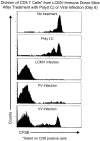CD8 T cell responses to viral infections in sequence
- PMID: 15056212
- PMCID: PMC7162374
- DOI: 10.1111/j.1462-5822.2004.00390.x
CD8 T cell responses to viral infections in sequence
Abstract
Our current understanding of virus-specific T cell responses has been shaped by model systems with mice, where naive animals are infected with a single viral pathogen. Paradigms derived from such models, however, may not always be applicable to a natural setting, where a host is exposed to numerous pathogens over its lifetime. Accumulating data in animal models and with some human diseases indicate that a host's prior history of infections can impact the specificity of future CD8 T cell responses, even to unrelated viruses. This can have both beneficial and detrimental consequences for the host, including altered clearance of virus, distinct forms of immunopathology, and substantial changes in the pool of memory T cells. Here we will describe the characteristics of CD8 T cells and the dynamics of their response to heterologous viral infections in sequence.
Figures



References
-
- Anderson, R.W. , Bennink, J.R. , Yewdell, J.W. , Maloy, W.L. , and Coligan, J.E. (1992) Influenza basic polymerase 2 peptides are recognized by influenza nucleoprotein‐specific cytotoxic T lymphocytes. Mol Immunol 29: 1089–1096. - PubMed
-
- Barber, G.N. (2001) Host defense, viruses and apoptosis. Cell Death Differ 8: 113–126. - PubMed
-
- Belz, G.T. , Stevenson, P.G. , and Doherty, P.C. (2000) Contemporary analysis of MHC‐related immunodominance hierarchies in the CD8+ T cell response to influenza A viruses. J Immunol 165: 2404–2409. - PubMed
-
- Belz, G.T. , Xie, W. , and Doherty, P.C. (2001) Diversity of epitope and cytokine profiles for primary and secondary influenza a virus‐specific CD8+ T cell responses. J Immunol 166: 4627–4633. - PubMed
Publication types
MeSH terms
Substances
Grants and funding
LinkOut - more resources
Full Text Sources
Medical
Research Materials

